A Fully Integrated System: Sentinel-2, Electromagnetic Induction and Laboratory Analyses for Mapping Mediterranean Topsoil Variability
Abstract
1. Introduction
2. Materials and Methods
2.1. Experimental Design
2.2. Study Area
2.2.1. Geographical and Agronomic Context
2.2.2. Climate
2.2.3. Soil Characteristics
2.3. Methods
2.3.1. Proximal Sensing: Electromagnetic Induction (EMI) Survey
EMI Data Acquisition
EMI Data Processing
2.3.2. Soil Sampling and Laboratory Analyses
2.3.3. Moisture Influence and Correction of EMI Data
2.3.4. Remote Sensing Data: Satellite Imagery and Index Derivation
2.3.5. Statistical Analysis
2.3.6. ECa–CI Data Fusion and Derivation of Management Zones
3. Results
3.1. Apparent Electrical Conductivity (ECa)
3.2. Laboratory Soil Analyses
3.3. Soil Moisture Influence on ECa Measurements
3.4. Sentinel-2 Spectral Indices
3.5. Correlation Analysis
3.6. Principal Component Analysis (PCA)
3.7. Regression Models
3.8. Field-Scale Zoning Based on ECa–CI Fusion
4. Discussion
4.1. Integration of Proximal and Satellite Data
4.2. Interpretation of Spatial Patterns
4.3. Methodological Reliability and Workflow Design
4.4. Limitations and Methodological Safeguards
4.5. Comparison with Literature and Broader Implications
5. Conclusions
Author Contributions
Funding
Data Availability Statement
Acknowledgments
Conflicts of Interest
Appendix A. Python Code for Climate Data Cleaning and Analysis
Appendix A.1. Data Pre-Processing
Appendix A.2. Climate Indices Calculation
Appendix A.3. Graphical Visualisation
- (a)
- Temperature and Precipitation for Eboli, combining mean, maximum, and minimum daily temperatures (°C) with cumulative monthly precipitation (mm) on a dual y-axis.
- (b)
- Cumulative Precipitation for Eboli, displaying the temporal trend of total monthly rainfall.
- (c)
- Climate Indices for Eboli, reporting monthly counts of frost days (Tmin ≤ 0 °C), summer days (Tmax > 25 °C), hot days (Tmax > 35 °C), and tropical nights (Tmin > 20 °C).
Appendix B. Kriging Interpolation and Validation of EMI Data
| Frequency (kHz) | Model Type | 1 Range (m) | Nugget | Sill | RMSE (mS m−1) | R2 | Regression Equation (Cross-Validation) |
|---|---|---|---|---|---|---|---|
| 3 | Isotropic linear | ≈120 | ≈40 | ≈140 | 2.881 | 0.918 | y = 1.024x − 2.223 |
| 7 | Isotropic linear | ≈120 | ≈35 | ≈120 | 2.342 | 0.935 | y = 1.035x − 2.714 |
| 14 | Isotropic linear | ≈120 | ≈30 | ≈125 | 2.151 | 0.949 | y = 1.027x − 1.848 |
Appendix C. Estimated Soil Hydraulic Parameters
Appendix C.1. Regional Pedological Profile (CP1P83)
| Profile | Depth (cm) | Texture | Organic Carbon (g kg−1) | 1 θ1500 (% v/v) | θ33 (% v/v) | θs (% v/v) | AWC (% v/v) | Bulk Density (ρb) (g cm−3) | PAW (mm) |
|---|---|---|---|---|---|---|---|---|---|
| CP1P83 | 0–30 | Clay-loam (22.3% sand, 38.4% silt, 39.3% clay) | 17 | 23.4 | 39 | 51.3 | 15.5 | 1.29 | 46.6 |
Appendix C.2. Field Sampling Locations: Estimation Procedure and Internal Consistency
| Sample ID | 1 θ1500 (m3 m−3) | θ33 (m3 m−3) | AWC (m3 m−3) | PAW (mm) |
|---|---|---|---|---|
| 1 | 0.23 | 0.37 | 0.14 | 42 |
| 2 | 0.24 | 0.38 | 0.14 | 43 |
| 3 | 0.23 | 0.39 | 0.16 | 48 |
| 4 | 0.22 | 0.37 | 0.15 | 45 |
| 5 | 0.24 | 0.4 | 0.16 | 48 |
| 6 | 0.23 | 0.39 | 0.16 | 47 |
| 7 | 0.23 | 0.38 | 0.15 | 46 |
| 8 | 0.24 | 0.4 | 0.16 | 48 |
| 9 | 0.22 | 0.36 | 0.14 | 43 |
| 10 | 0.23 | 0.39 | 0.16 | 47 |
| 11 | 0.25 | 0.41 | 0.16 | 48 |
| 12 | 0.24 | 0.4 | 0.16 | 47 |
| Mean ± SD | 0.23 ± 0.01 | 0.39 ± 0.02 | 0.15 ± 0.01 | 46 ± 2 |
References
- Gasmi, A.; Gomez, C.; Chehbouni, A.; Dhiba, D.; Elfil, H. Satellite multi-sensor data fusion for soil clay mapping based on the spectral index and spectral bands approaches. Remote Sens. 2022, 14, 1103. [Google Scholar] [CrossRef]
- Kosma, C.; Triantafyllidis, V.; Zotos, A.; Pittaras, A.; Kouneli, V.; Karydogianni, S.; Mavroeidis, A.; Kakabouki, I.; Beslemes, D.; Tigka, E.L.; et al. Assessing spatial variability of soil properties in Mediterranean smallholder farming systems. Land 2022, 11, 557. [Google Scholar] [CrossRef]
- Dharumarajan, S.; Hegde, R.; Janani, N.; Singh, S.K. The need for digital soil mapping in India. Geoderma Reg. 2019, 16, e00204. [Google Scholar] [CrossRef]
- Metwally, M.S.; Shaddad, S.M.; Liu, M.; Yao, R.-J.; Abdo, A.I.; Li, P.; Jiao, J.; Chen, X. Soil properties spatial variability and delineation of site-specific management zones based on soil fertility using fuzzy clustering in a hilly field in Jianyang, Sichuan, China. Sustainability 2019, 11, 7084. [Google Scholar] [CrossRef]
- Vaudour, E.; Gomez, C.; Fouad, Y.; Lagacherie, P. Sentinel-2 image capacities to predict common topsoil properties of temperate and Mediterranean agroecosystems. Remote Sens. Environ. 2019, 223, 21–33. [Google Scholar] [CrossRef]
- Elnashar, A.; Hussein, H.; Goma, R.; El Baroudy, A.; Belal, A. Potential of Sentinel-2 Images for Estimating of Soil Resistivity over Agricultural Fields. Remote Sens. Appl. Soc. Environ. 2019, 15, 100243. [Google Scholar] [CrossRef]
- Serrano, J.; Shahidian, S.; Moral, F.; Marques da Silva, J.; Paixão, L. Integration of soil electrical conductivity and indices obtained through satellite imagery for differential management of pasture fertilization. AgriEngineering 2019, 1, 567–585. [Google Scholar] [CrossRef]
- Serrano, J.; Shahidian, S.; Paixão, L.; Marques da Silva, J.; Moral, F. Management zones in pastures based on soil apparent electrical conductivity and altitude: NDVI, soil and biomass sampling validation. Agronomy 2022, 12, 778. [Google Scholar] [CrossRef]
- Grobler, E.; Celano, G. Photogrammetric and LiDAR Scanning with iPhone 13 Pro: Accuracy, Precision and Field Application on Hazelnut Trees. Sensors 2025, 25, 5629. [Google Scholar] [CrossRef]
- Win, K.; Sato, T.; Hiroshima, T. Applicability of remote sensing and machine learning for predicting bulk soil electrical conductivity under different forest types in central Japan. Soil Adv. 2025, 3, 100045. [Google Scholar] [CrossRef]
- Bréchet, L.; Oatham, M.; Wuddivira, M.; Robinson, D.A. Determining spatial variation in soil properties in teak and native tropical forest plots using electromagnetic induction. Vadose Zone J. 2012, 11, vzj2011.0102. [Google Scholar] [CrossRef]
- Climate-Data.org. Climate: Eboli (Campania, Italy). Available online: https://en.climate-data.org/europe/italy/campania/eboli-14220/ (accessed on 25 September 2025).
- Capozzi, V.; Russo, F.; Mariani, L.; Montanari, A. Signals of change in the Campania region rainfall regime: An analysis of extreme precipitation indices (2002–2021). Meteorol. Appl. 2023, 30, e2168. [Google Scholar] [CrossRef]
- Regione Campania. Agrometeo Campania—Eboli (SA) Monitoring Station. Available online: https://agricoltura.regione.campania.it/meteo/dati_2025/eboli_2025.html (accessed on 16 September 2025).
- Regione Campania. I Suoli della Piana del Sele—Destra Idrografica; Progetto Carta dei Suoli della Campania 1:50.000; Regione Campania—Assessorato Agricoltura: Napoli, Italy, 2012. [Google Scholar]
- McNeill, J.D. Electromagnetic Terrain Conductivity Measurement at Low Induction Numbers; Technical Note TN-6; Geonics Limited: Mississauga, ON, Canada, 1980; Available online: https://geonics.com/pdfs/technicalnotes/tn6.pdf (accessed on 2 November 2025).
- Doolittle, J.A.; Brevik, E.C. The use of electromagnetic induction techniques in soils studies. Geoderma 2014, 223, 33–45. [Google Scholar] [CrossRef]
- Corwin, D.L.; Lesch, S.M. Applications of apparent soil electrical conductivity in precision agriculture. Comput. Electron. Agric. 2005, 46, 11–43. [Google Scholar] [CrossRef]
- GSSI. EMP-400 Profiler: User Manual; Geophysical Survey Systems Inc.: Nashua, NH, USA, 2023. [Google Scholar]
- GSSI. Profiler EMP-400—Product Page/Brochure. Available online: https://www.geophysical.com (accessed on 9 October 2025).
- Saey, T.; Simpson, D.; Vermeersch, H.; Cockx, L.; Van Meirvenne, M. Comparing the EM38DD and DUALEM-21S Sensors for Depth-to-Clay Mapping. Soil Sci. Soc. Am. J. 2009, 73, 7–12. [Google Scholar] [CrossRef]
- Tazifor, M.; von Hebel, C.; Zimmermann, E. Model-Based Correction of Temperature-Dependent Measurement Errors in Frequency Domain Electromagnetic Induction (FDEMI) Systems. Sensors 2022, 22, 3882. [Google Scholar] [CrossRef]
- Pereira, G.W.; Valente, D.S.M.; Queiroz, D.M.D.; Coelho, A.L.D.F.; Hurtado, S.M.C.; Costa, M.M.; Grift, T. Smart-Map: An Open-Source QGIS Plugin for Digital Mapping Using Machine Learning Techniques and Ordinary Kriging. Agronomy 2022, 12, 1350. [Google Scholar] [CrossRef]
- QGIS Python Plugins Repository—Smart-Map. Available online: https://plugins.qgis.org (accessed on 25 September 2025).
- Lesch, S.M.; Rhoades, J.D.; Corwin, D.L. ESAP-95 Version 2.01R: User Manual and Tutorial Guide; Research Report No. 146; U.S. Salinity Laboratory, USDA-ARS: Riverside, CA, USA, 2000. Available online: https://www.ars.usda.gov/arsuserfiles/20360500/pdf_pubs/P1702.pdf (accessed on 25 September 2025).
- USDA-ARS. ESAP Software Suite: XP-Release Version 2.35—User Guide; U.S. Salinity Laboratory, USDA-ARS: Riverside, CA, USA, 2003. Available online: https://irrigationtoolbox.com/NEH/UserGuides/ESAP2Point35.pdf (accessed on 25 September 2025).
- Walkley, A.; Black, I.A. An examination of the Degtjareff method for determining soil organic matter and a proposed modification of the chromic acid titration method. Soil Sci. 1934, 37, 29–38. [Google Scholar] [CrossRef]
- Pauwels, J.M.; Van Ranst, E.; Verloo, M.; Mvondo Ze, A. Méthode d’Analyse de Sols et de Plantes, Gestion de Stock de Verrerie et de Produits Chimiques. Manuel de Laboratoire de Pédologie; Publications Agricoles, AGCD: Bruxelles, Belgium, 1992; p. 28. [Google Scholar]
- Nativel, S.; Ayari, E.; Rodriguez-Fernandez, N.; Baghdadi, N.; Madelon, R.; Albergel, C.; Zribi, M. Hybrid Methodology Using Sentinel-1/Sentinel-2 for Soil Moisture Estimation. Remote Sens. 2022, 14, 2434. [Google Scholar] [CrossRef]
- Rikimaru, A.; Roy, P.S.; Miyatake, S. Tropical Forest cover density mapping. Trop. Ecol. 2002, 43, 39–47. [Google Scholar]
- Pukelsheim, F. The three-sigma rule. Am. Stat. 1994, 48, 88–91. [Google Scholar] [CrossRef]
- Little, R.J.A.; Rubin, D.B. Statistical Analysis with Missing Data, 3rd ed.; Wiley: Hoboken, NJ, USA, 2019. [Google Scholar] [CrossRef]
- Kaiser, H.F. An index of factorial simplicity. Psychometrika 1974, 39, 31–36. [Google Scholar] [CrossRef]
- Jolliffe, I.T.; Cadima, J. Principal component analysis: A review and recent developments. Philos. Trans. R. Soc. A 2016, 374, 20150202. [Google Scholar] [CrossRef]
- Bartlett, M.S. Tests of significance in factor analysis. Br. J. Psychol. 1950, 3, 77–85. [Google Scholar] [CrossRef]
- Fox, J.; Weisberg, S. An R Companion to Applied Regression, 3rd ed.; SAGE: Thousand Oaks, CA, USA, 2019; Available online: https://www.john-fox.ca/Companion/ (accessed on 2 November 2025).
- Wickham, H. ggplot2: Elegant Graphics for Data Analysis, 2nd ed.; Springer: Cham, Switzerland, 2016. [Google Scholar] [CrossRef]
- Revelle, W. psych: Procedures for Psychological, Psychometric, and Personality Research, R package version 2.5.6; Northwestern University: Evanston, IL, USA, 2025; Available online: https://cran.r-project.org/package=psych (accessed on 1 October 2025).
- Maier, M.J. REdaS: Companion Package to the Book “R: Einführung Durch Angewandte Statistik”; R Package Version 0.9.4. 2022. Available online: https://cran.r-project.org/package=REdaS (accessed on 25 September 2025).
- Kolde, R. pheatmap: Pretty Heatmaps. R Package Version 1.0.13. 2025. Available online: https://cran.r-project.org/package=pheatmap (accessed on 25 September 2025).
- Bougiouklis, J.N.; Barouchas, P.E.; Petropoulos, P.; Tsesmelis, D.E.; Moustakes, N. Precision soil sampling strategy for the delineation of management zones in olive cultivation using unsupervised machine learning methods. Sci. Rep. 2025, 15, 89395. [Google Scholar] [CrossRef]
- Saxton, K.E.; Rawls, W.J. Soil Water Characteristic Estimates by Texture and Organic Matter for Hydrologic Solutions. Soil Sci. Soc. Am. J. 2006, 70, 1569–1578. [Google Scholar] [CrossRef]
- Abou Najm, M.R.; Al-Mashaqbeh, I.A.; Al-Karablieh, E.K.; Kandakji, T.; Shatnawi, A.; Al-Zubi, Y.; Masri, Z. Sensor fusion of proximal and remote sensing data improves soil management zone delineation and prediction of soil properties. Soil Tillage Res. 2024, 242, 105866. [Google Scholar] [CrossRef]
- Win, K.; Sato, T.; Hiroshima, T.; Matsumoto, K.; Takahashi, S.; Yamamoto, Y. Integrating proximal geophysical surveys with Sentinel-2 imagery improves soil property mapping across agroecosystems. SOIL 2025, 11, 655–670. [Google Scholar] [CrossRef]
- FAO. Guidelines for Soil Description, 4th ed.; Food and Agriculture Organization of the United Nations: Rome, Italy, 2006. [Google Scholar]

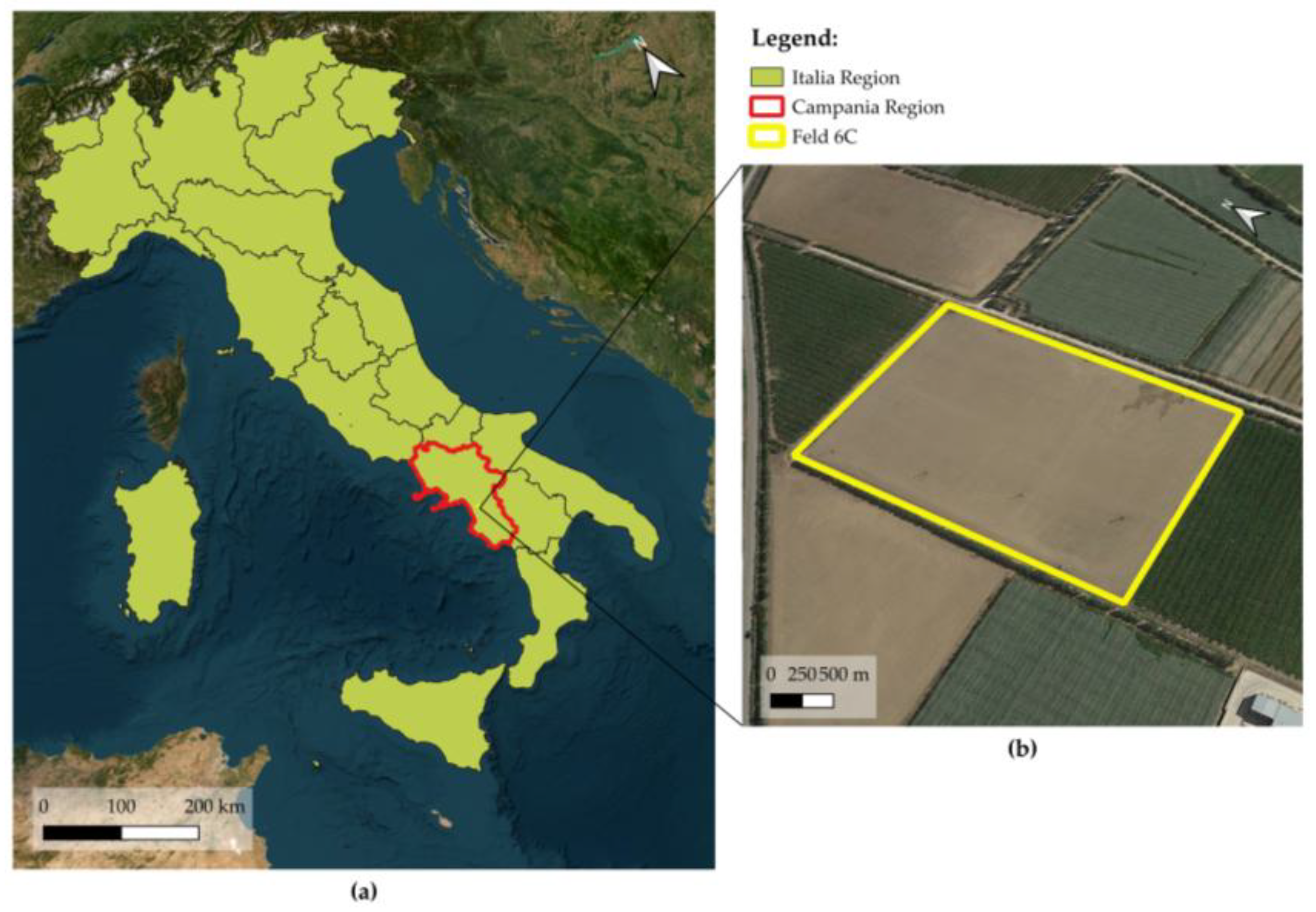
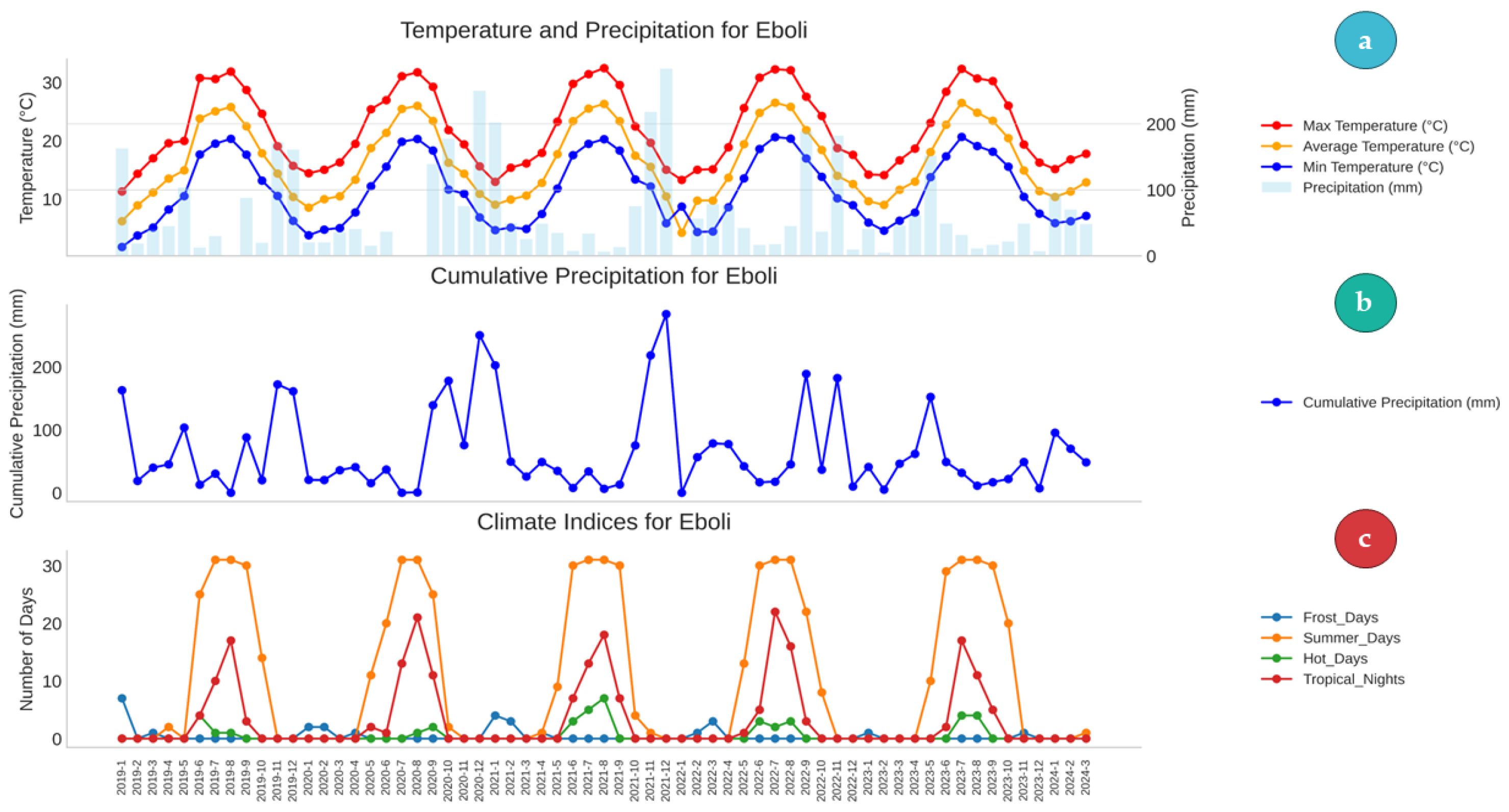
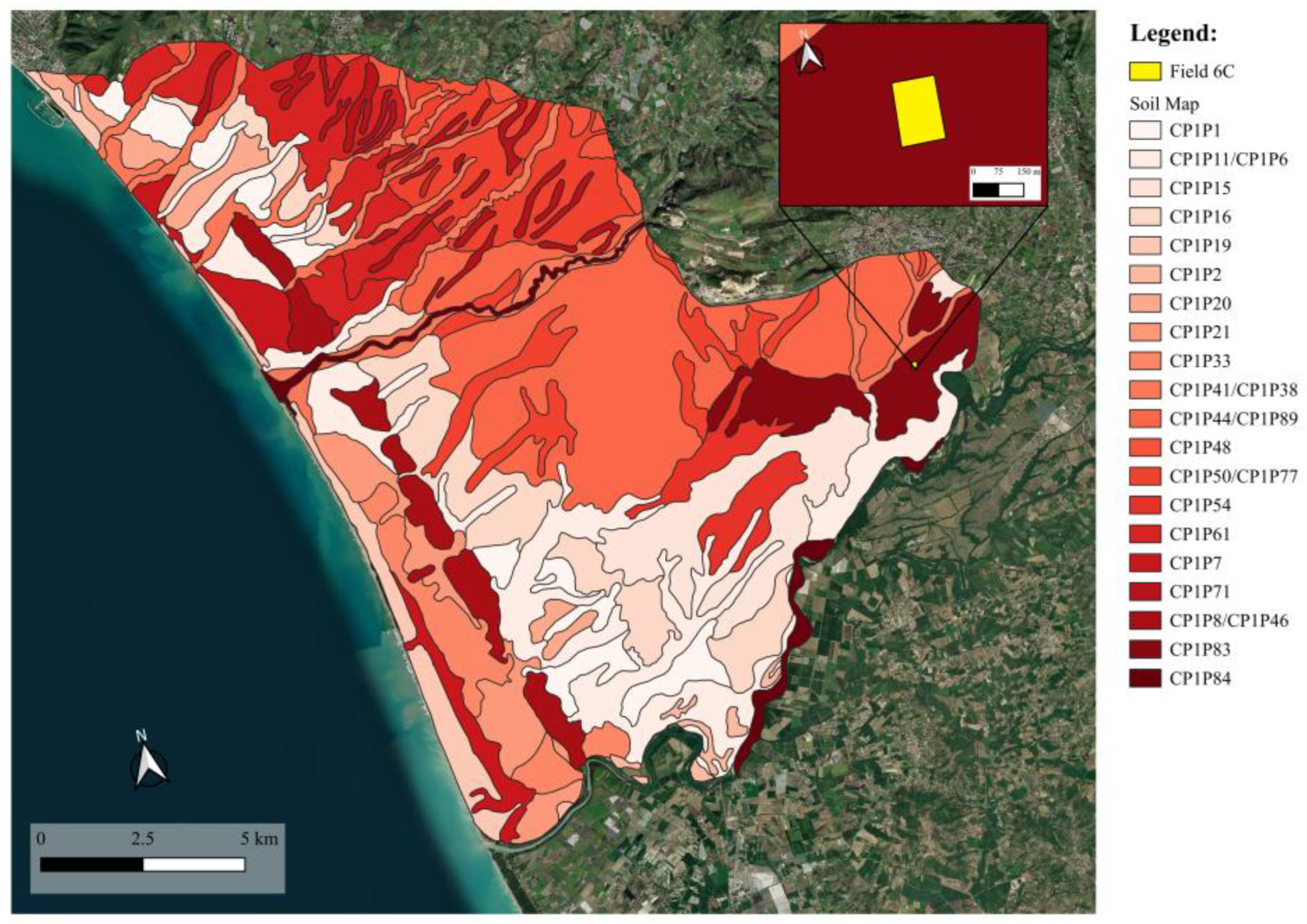


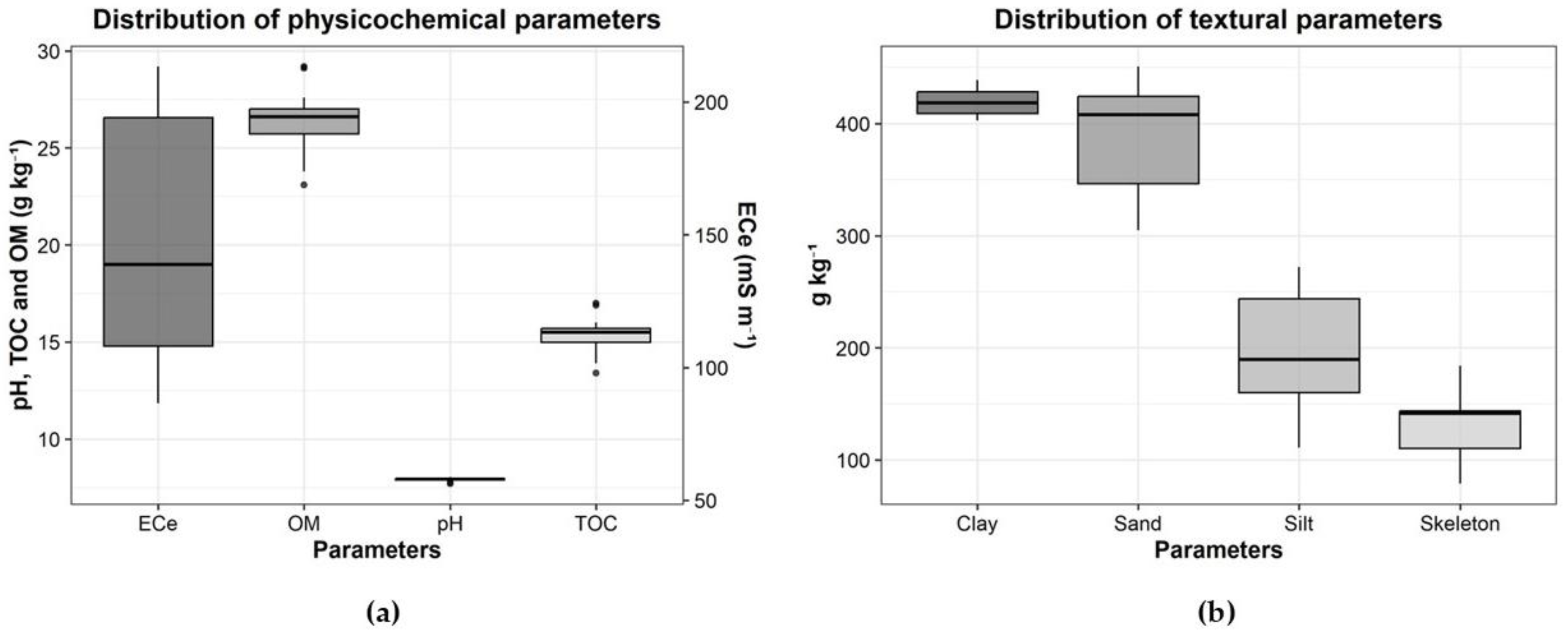


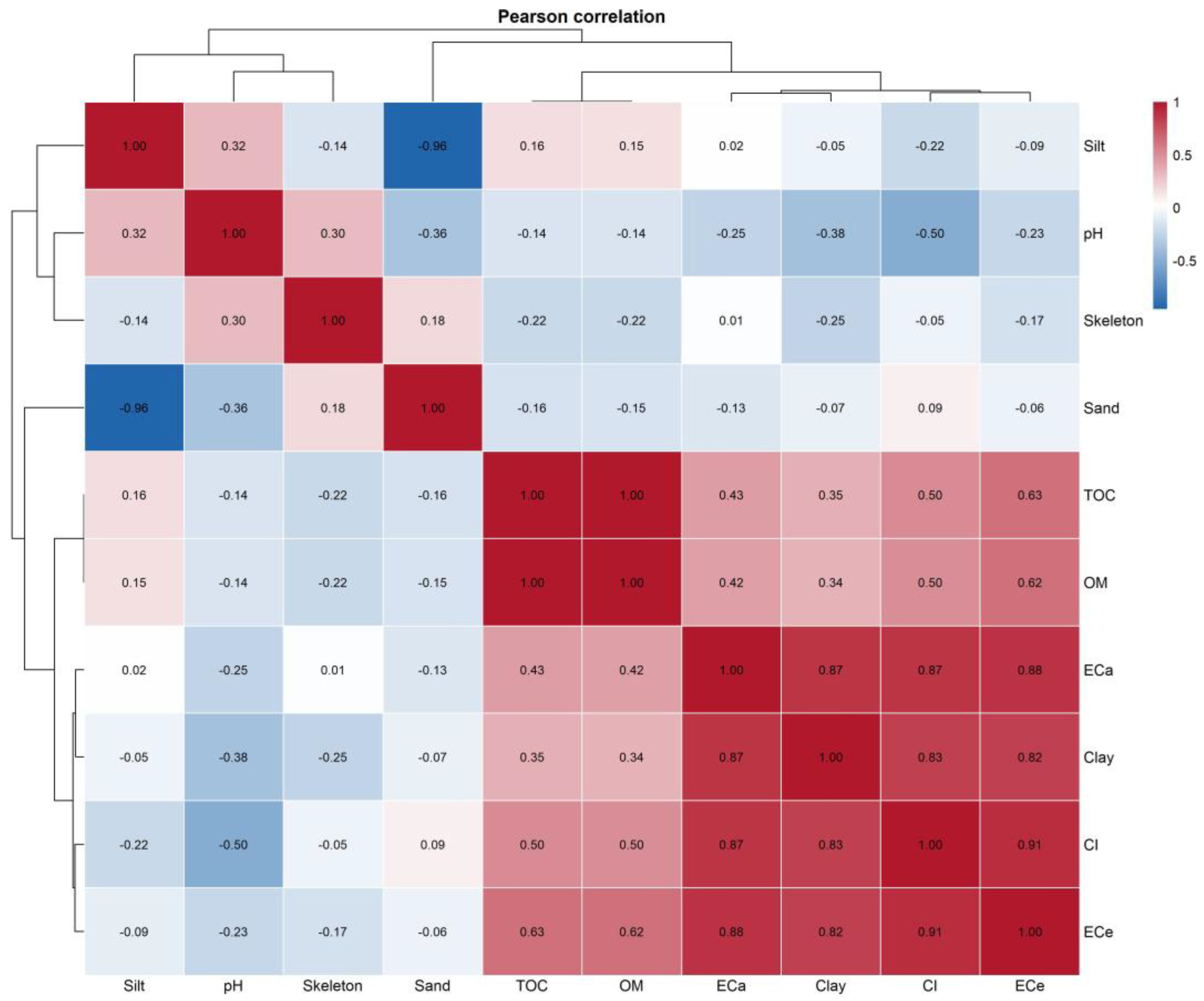


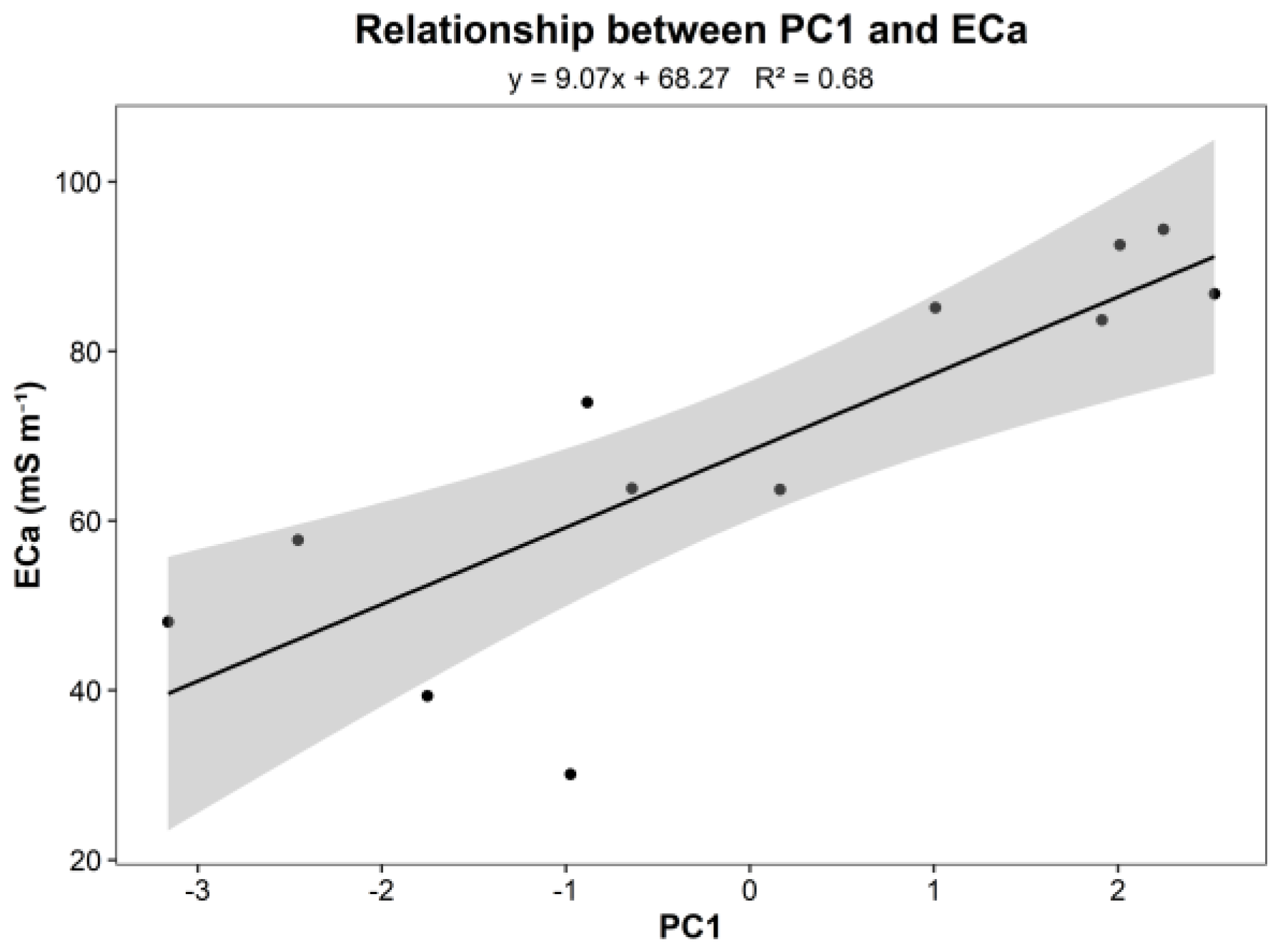

| Climate Index | Calculation Criterion |
|---|---|
| Frost Days | Count of days with Tmin <= 0 °C |
| Summer Days | Count of days with Tmax > 25 °C |
| Hot Days | Count of days with Tmax > 35 °C |
| Tropical Nights | Count of days with Tmin > 20 °C |
| Cumulative Precipitation | Sum of daily precipitation amounts |
| Maximum Temperature | Daily maximum air temperature (Tmax) |
| Average Temperature | Daily mean air temperature (Tmed) |
| Minimum Temperature | Daily minimum air temperature (Tmin) |
| Profile | Depth (cm) | Sand (g kg−1) | Silt (g kg−1) | Clay (g kg−1) | pH | CEC 1 (meq kg−1) | Organic Carbon (g kg−1) |
|---|---|---|---|---|---|---|---|
| CP1P83 | 0–30 | 223 | 384 | 393 | 8.6 | 257 | 17 |
| CP1P83 | 30–85 | 263 | 404 | 333 | 8.2 | 251 | 8 |
| CP1P83 | 85–150 | 303 | 466 | 231 | 8.1 | 260 | 7 |
| Profile | Depth (cm) | Total Carbonates (g kg−1) | Exchangeable Sodium (meq kg−1) | Exchangeable Potassium (meq kg−1) | Exchangeable Calcium (meq kg−1) | Exchangeable Magnesium (meq kg−1) |
|---|---|---|---|---|---|---|
| CP1P83 | 0–30 | 278 | 15.2 | 36.9 | 150.3 | 54.5 |
| CP1P83 | 30–85 | 270 | 7.2 | 6.9 | 209.8 | 24.0 |
| CP1P83 | 85–150 | 255 | 1.8 | 4.9 | 226.7 | 26.4 |
| Band | Spectral Region | Central Wavelength (ρ, nm) | Spatial Resolution (m) |
|---|---|---|---|
| Blue | Visible | 490 | 10 |
| Red | Visible | 665 | 10 |
| NIR | Near infrared | 842 | 10 |
| SWIR1 | Shortwave IR | 1610 | 20 |
| SWIR2 | Shortwave IR | 2190 | 20 |
| Frequency (kHz) | Min | Mean | Max | Std. Dev 1 |
|---|---|---|---|---|
| 14 kHz | 33.7 | 74.8 | 107.5 | 75.9 |
| 7 kHz | 40.0 | 82.7 | 114.1 | 83.8 |
| 3 kHz | 50.9 | 95.8 | 163.5 | 97.0 |
| Soil Properties | n 1 | Min | Mean | Max | Std. Dev | SEM | CV |
|---|---|---|---|---|---|---|---|
| pH | 12 | 7.7 | 7.9 | 8.0 | 0.1 | 0.0 | 1.2 |
| ECe | 12 | 86.6 | 148.3 | 213.4 | 45.3 | 13.1 | 30.6 |
| Skeleton | 12 | 79 | 129 | 184 | 30.5 | 8.8 | 23.6 |
| Sand | 12 | 305 | 390 | 451 | 50.9 | 14.7 | 13.0 |
| Silt | 12 | 111 | 193 | 272 | 53.1 | 15.3 | 27.6 |
| Clay | 12 | 403 | 419 | 439 | 12.1 | 3.5 | 2.9 |
| TOC | 12 | 13.4 | 15.4 | 17.0 | 1.0 | 0.3 | 6.8 |
| OM | 12 | 23.1 | 26.4 | 29.2 | 1.8 | 0.5 | 6.8 |
| Variable | r | R2 |
|---|---|---|
| 1 ECe | 0.884 | 0.781 |
| Clay | 0.872 | 0.761 |
| CI | 0.872 | 0.760 |
| TOC | 0.434 | 0.188 |
| OM | 0.420 | 0.177 |
| pH | −0.250 | 0.063 |
| Sand | −0.131 | 0.017 |
| Silt | 0.024 | 0.001 |
| Skeleton | 0.012 | 0.000 |
| Variable | PC1 | PC2 |
|---|---|---|
| 1 ECe | 0.48 | 0.05 |
| Clay | 0.42 | 0.36 |
| CI | 0.47 | 0.28 |
| TOC | 0.4 | −0.52 |
| OM | 0.4 | −0.52 |
| pH | −0.23 | −0.5 |
Disclaimer/Publisher’s Note: The statements, opinions and data contained in all publications are solely those of the individual author(s) and contributor(s) and not of MDPI and/or the editor(s). MDPI and/or the editor(s) disclaim responsibility for any injury to people or property resulting from any ideas, methods, instructions or products referred to in the content. |
© 2025 by the authors. Licensee MDPI, Basel, Switzerland. This article is an open access article distributed under the terms and conditions of the Creative Commons Attribution (CC BY) license (https://creativecommons.org/licenses/by/4.0/).
Share and Cite
Lepore, A.; De Rosa, G.; Grobler, E.; Celano, G. A Fully Integrated System: Sentinel-2, Electromagnetic Induction and Laboratory Analyses for Mapping Mediterranean Topsoil Variability. Appl. Sci. 2025, 15, 11796. https://doi.org/10.3390/app152111796
Lepore A, De Rosa G, Grobler E, Celano G. A Fully Integrated System: Sentinel-2, Electromagnetic Induction and Laboratory Analyses for Mapping Mediterranean Topsoil Variability. Applied Sciences. 2025; 15(21):11796. https://doi.org/10.3390/app152111796
Chicago/Turabian StyleLepore, Alessandra, Giovanni De Rosa, Elèna Grobler, and Giuseppe Celano. 2025. "A Fully Integrated System: Sentinel-2, Electromagnetic Induction and Laboratory Analyses for Mapping Mediterranean Topsoil Variability" Applied Sciences 15, no. 21: 11796. https://doi.org/10.3390/app152111796
APA StyleLepore, A., De Rosa, G., Grobler, E., & Celano, G. (2025). A Fully Integrated System: Sentinel-2, Electromagnetic Induction and Laboratory Analyses for Mapping Mediterranean Topsoil Variability. Applied Sciences, 15(21), 11796. https://doi.org/10.3390/app152111796








